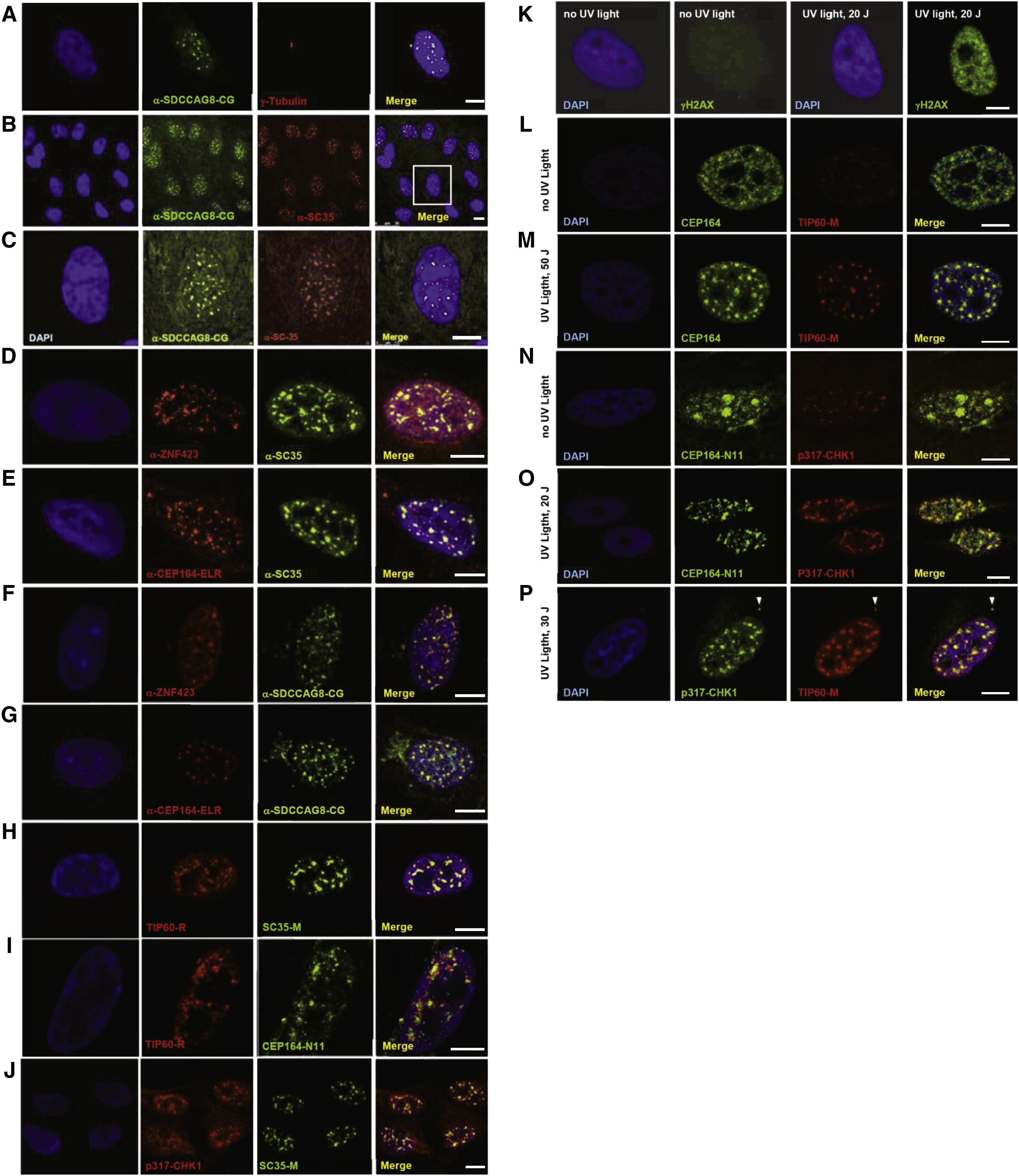Fig. 4
Colocalization upon Immunofluorescence of the NPHP-RC Proteins SDCCAG8/NPHP10, ZNF423 and CEP164 to Nuclear Foci that Are Positive for the DDR Signaling Proteins SC35, TIP60 and Chk1 in hTERT-RPE Cells (A–G) Colocalization of NPHP-RC proteins with SC35 in nuclear foci. SDCCAG8/NPHP10 (A-C) and ZNF423 (D) fully colocalize to nuclear foci with SC35, and (E) CEP164 partially colocalizes with SC35. SDCCAG8/ NPHP10 also colocalizes with the identified NPHP-RC proteins ZNF423 (F) and CEP164 (G). (H–J) Colocalization of NPHP-RC proteins with the DDR protein TIP60 and Chk1 to nuclear foci. (H) TIP60 fully colocalizes with SC35. (I) TIP60 partially colocalizes with CEP164. (J) Chk1 fully colocalizes with SC35/ SRSF2. DNA is stained in blue with DAPI. Scale bars, 5 μm. (K–P) Colocalization of DDR and NPHP proteins upon induction of DDR by UV radiation in HeLa cells. (K) Following irradiation of HeLa cells with UV light at 20 J/m2 a strong immunofluorescence signal of an anti-γH2AX antibody indicates activation of DDR. (L–M) Upon irradiation with UV light, CEP164-positive nuclear foci condense and colocalize with TIP60 foci of similar size. (N–O) In untreated cells (N) a pattern of broad CEP164 speckles, which are Chk1-negative and locate to DAPI-negative domains, changes to a pattern of multiple smaller foci (O) that are double positive for both CEP164-N11 and Chk1. (P) p317-Chk1 fully colocalizes with TIP60 to nuclear foci and to the centrosome (arrowhead). See also Figures S4, S5A, and S5B.
Reprinted from Cell, 150(3), Chaki, M., Airik, R., Ghosh, A.K., Giles, R.H., Chen, R., Slaats, G.G., Wang, H., Hurd, T.W., Zhou, W., Cluckey, A., Gee, H.Y., Ramaswami, G., Hong, C.J., Hamilton, B.A., Cervenka, I., Ganji, R.S., Bryja, V., Arts, H.H., van Reeuwijk, J., Oud, M.M., Letteboer, S.J., Roepman, R., Husson, H., Ibraghimov-Beskrovnaya, O., Yasunaga, T., Walz, G., Eley, L., Sayer, J.A., Schermer, B., Liebau, M.C., Benzing, T., Le Corre, S., Drummond, I., Janssen, S., Allen, S.J., Natarajan, S., O'Toole, J.F., Attanasio, M., Saunier, S., Antignac, C., Koenekoop, R.K., Ren, H., Lopez, I., Nayir, A., Stoetzel, C., Dollfus, H., Massoudi, R., Gleeson, J.G., Andreoli, S.P., Doherty, D.G., Lindstrad, A., Golzio, C., Katsanis, N., Pape, L., Abboud, E.B., Al-Rajhi, A.A., Lewis, R.A., Omran, H., Lee, E.Y., Wang, S., Sekiguchi, J.M., Saunders, R., Johnson, C.A., Garner, E., Vanselow, K., Andersen, J.S., Shlomai, J., Nurnberg, G., Nurnberg, P., Levy, S., Smogorzewska, A., Otto, E.A., and Hildebrandt, F., Exome Capture Reveals ZNF423 and CEP164 Mutations, Linking Renal Ciliopathies to DNA Damage Response Signaling, 533-548, Copyright (2012) with permission from Elsevier. Full text @ Cell

